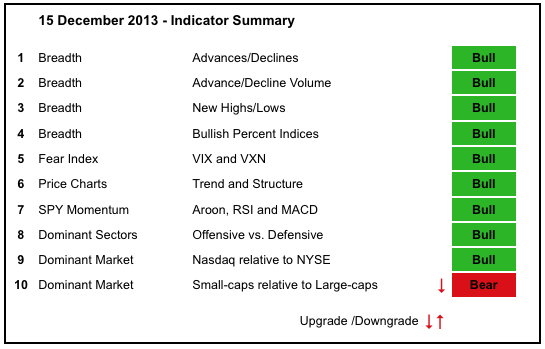The December pullback weakened a few indicators, but the bulk of the long-term evidence remains bullish. Most notably, the NYSE AD Line formed a small bearish divergence, as did the NYSE AD Volume Line. The Nasdaq AD Line and AD Volume Line, however, did not form divergences and techs remain strong overall. Small-caps, on the other hand, underperformed in December and I am downgrading this indicator to bearish. Relative weakness may be part of a correction, but the $RUT:$OEX ratio needs a breakout to put small-caps back in outperformance mode.
- AD Lines: Bullish. The Nasdaq AD Line hit a new high at the end of November and pulled back sharply in December, but the overall trend remains up. The NYSE AD Line formed a small bearish divergence over the last 2-3 months and broke below the mid November low.
- AD Volume Lines: Bullish. The Nasdaq AD Volume Line hit a new high in late November and the NYSE AD Volume Line hit a new high in mid November. Both have pulled back the last few weeks, but remain in uptrends overall.
- Net New Highs: Bullish. NY Net New Highs dipped into negative territory and Nasdaq Net New Highs are near zero. This is normal during a pullback. Note that these indicators bounced near the zero line throughout 2013.
- Bullish Percent Indices: Bullish. All nine sector Bullish Percent Indices are above 50%.
- VIX/VXN: Bullish. The S&P 500 Volatility Index ($VIX) and the Nasdaq 100 Volatility Index ($VXN) surged over the last three weeks, but volatility remains at low levels overall.
- Trend-Structure: Bullish. DIA, SPY, MDY and IWM hit new highs in late November and remain in long-term uptrend. QQQ hit a new high in early December and remains in a long-term uptrend.
- SPY Momentum: Bullish. RSI slipped back to its support zone (40-50). MACD(5,35,5) rolled over, but remains in positive territory. The Aroon Oscillator also remains strong (above 50).
- Offensive Sector Performance: Bullish. XLY, XLK and XLI hit new highs in late November, and XLK hit a new high in early December.
- Nasdaq Performance: Bullish. The $COMPQ:$NYA ratio stalled from mid October to mid November and then surged to new highs over the last few weeks.
- Small-cap Performance: Bearish. The $RUT:$OEX ratio bounced in late November, but fell back sharply in December and remains in a downtrend since early October.
- Breadth charts (here) and intermarket charts (here) have been updated.
This table is designed to offer an objective look at current market conditions. It does not aim to pick tops or bottoms. Instead, it seeks to identify noticeable shifts in buying and selling pressure.
This commentary and charts-of-interest are designed to stimulate thinking. This analysis is not a recommendation to buy, sell, hold or sell short any security (stock ETF or otherwise). We all need to think for ourselves when it comes to trading our own accounts. First, it is the only way to really learn. Second, we are the only ones responsible for our decisions. Think of these charts as food for further analysis. Before making a trade, it is important to have a plan. Plan the trade and trade the plan. Among other things, this includes setting a trigger level, a target area and a stop-loss level. It is also important to plan for three possible price movements: advance, decline or sideways. Have a plan for all three scenarios

